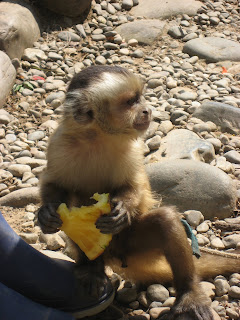
Yesterday I had a taxi driver only on the job five days and not yet jaded by the endless queue of passengers. He told me about a festival for the Holy Child that would be taking place in a small town this weekend. He was planning to go and urged me to consider it, saying it would be a beautiful sight.
A call came in from the dispatcher, ordering his taxi to his mother’s house. I laughed.
“Is your mother your customer?” I asked.
“She makes empanadas and when someone wants a delivery of empanadas, I transport them,” he said. “If you ever want a wonderful empanada, you should try hers. She’s been making them for 27 years.”
I had a busy day yesterday, finishing up my work and all the errands I wanted to finish in Santa Cruz. It was better to be busy than not though, as I’d reached the point where I was just counting the hours until my departure. In the evening, several of my colleagues took me out to dinner – a delicious meal of fried yucca pieces with various sauces, a chicken breast in cheese sauce, vegetables and potatoes. My Spanish teacher Oscar gave me our first baby blanket – a soft, pretty yellow blanket with a little arc full of animals on it.
The light was soft and gentle when I left this morning, the sun rising from a mottled sky, the palm trees on the way to the airport waving in the light breeze. There were no blockages, no protests, just the quiet normality of a city getting ready to go to work.
Overall, the city and the country have been good to me. I’ve met a lot of kind people and have generally had good experiences over the last five months. However, the country hasn’t taken a hold on my heart the way Kyrgyzstan did. It was painful to leave the land and the people of Kyrgyzstan as I felt it had become a part of me. Here, I remained a visitor, someone here temporarily. I was glad to have a final chance to spend time with colleagues. But I don’t have a connection with the land. And rather than with regret, I leave happily, eager to start a new adventure in the U.S., happy for the first time in years to be able to set up a home and family, however short-term it may be.
A call came in from the dispatcher, ordering his taxi to his mother’s house. I laughed.
“Is your mother your customer?” I asked.
“She makes empanadas and when someone wants a delivery of empanadas, I transport them,” he said. “If you ever want a wonderful empanada, you should try hers. She’s been making them for 27 years.”
I had a busy day yesterday, finishing up my work and all the errands I wanted to finish in Santa Cruz. It was better to be busy than not though, as I’d reached the point where I was just counting the hours until my departure. In the evening, several of my colleagues took me out to dinner – a delicious meal of fried yucca pieces with various sauces, a chicken breast in cheese sauce, vegetables and potatoes. My Spanish teacher Oscar gave me our first baby blanket – a soft, pretty yellow blanket with a little arc full of animals on it.
The light was soft and gentle when I left this morning, the sun rising from a mottled sky, the palm trees on the way to the airport waving in the light breeze. There were no blockages, no protests, just the quiet normality of a city getting ready to go to work.
Overall, the city and the country have been good to me. I’ve met a lot of kind people and have generally had good experiences over the last five months. However, the country hasn’t taken a hold on my heart the way Kyrgyzstan did. It was painful to leave the land and the people of Kyrgyzstan as I felt it had become a part of me. Here, I remained a visitor, someone here temporarily. I was glad to have a final chance to spend time with colleagues. But I don’t have a connection with the land. And rather than with regret, I leave happily, eager to start a new adventure in the U.S., happy for the first time in years to be able to set up a home and family, however short-term it may be.


























